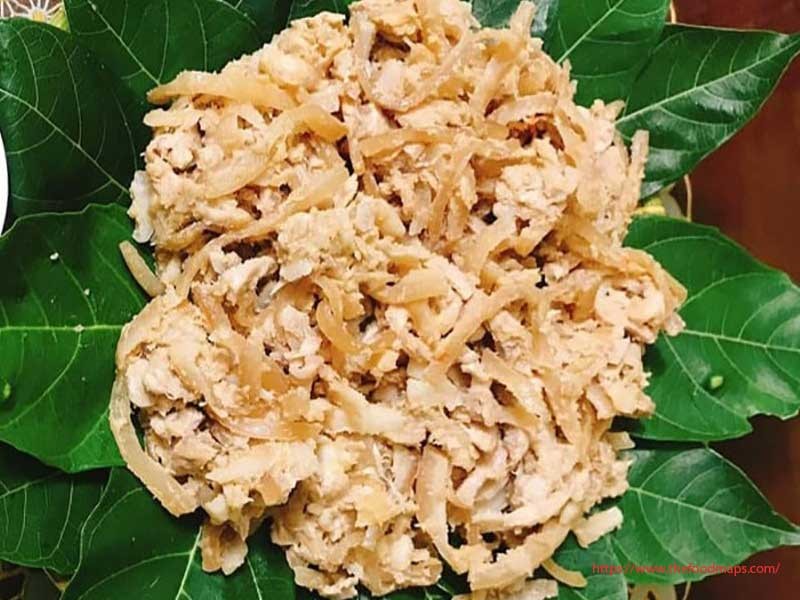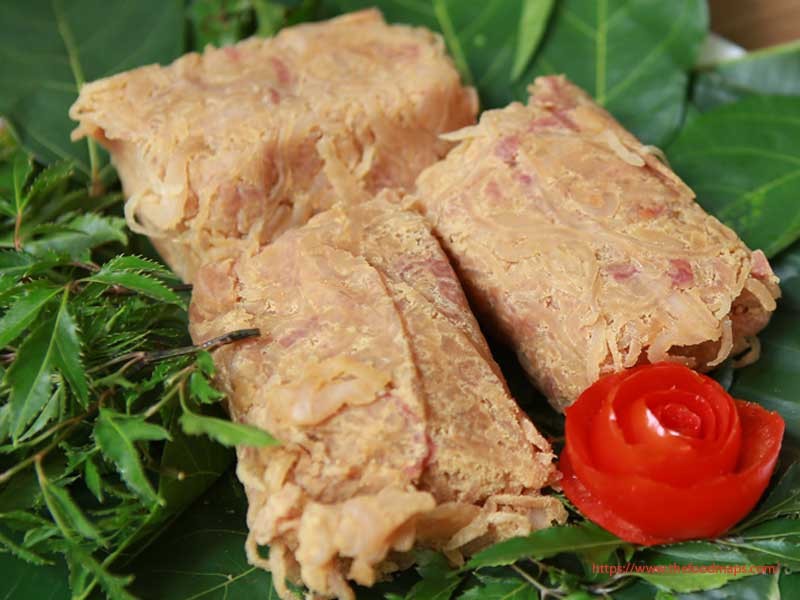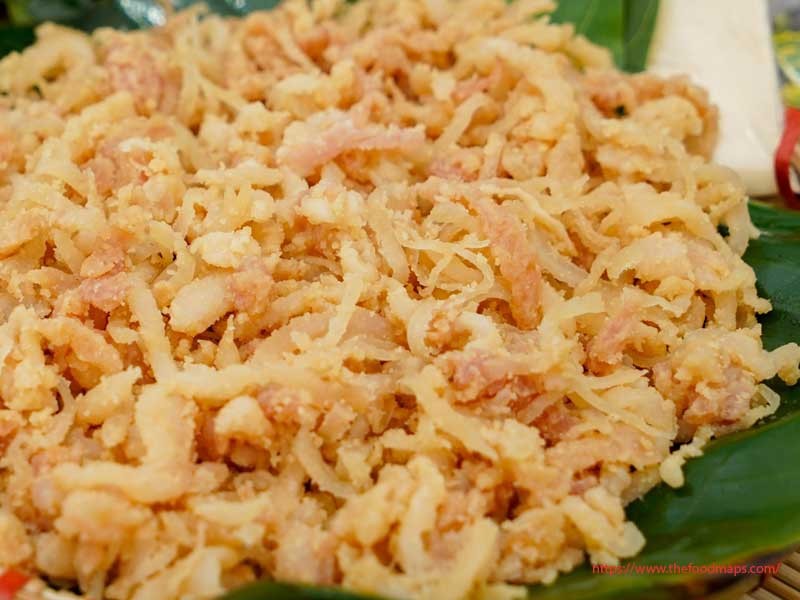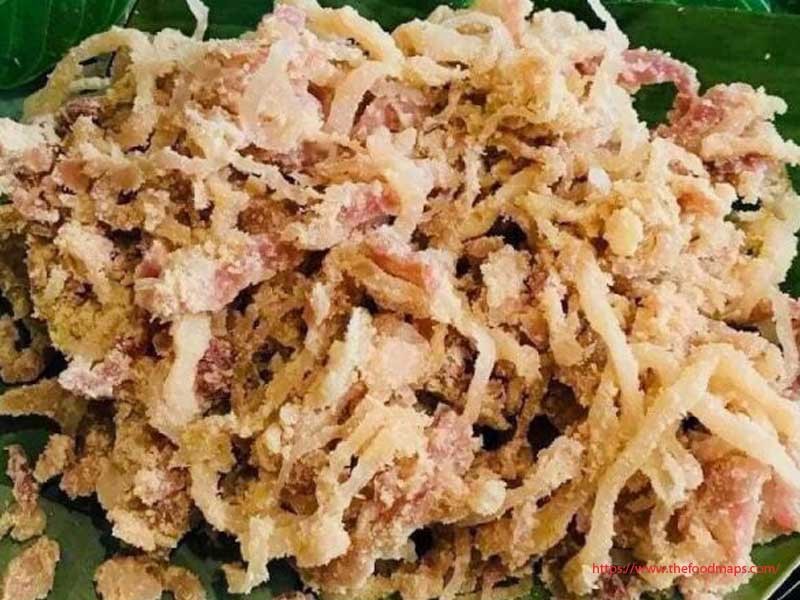Discover the secrets of preserving Nem Bui, a traditional Vietnamese delicacy, with SIXT.VN. Unlock the cultural significance and unique flavors of this Bắc Ninh specialty through expert guidance and convenient travel services. Explore Vietnam’s culinary heritage and savor authentic local experiences with confidence.
1. What Exactly Is Nem Bui and Why Should You Care?
Nem Bui is a fermented pork roll originating from Bùi Village in Bắc Ninh Province, Vietnam. This isn’t just another snack; it’s a cultural symbol, representing the rich traditions of the Kinh Bắc region. According to the Vietnam National Administration of Tourism, culinary tourism is a rapidly growing sector, attracting visitors eager to experience authentic flavors and cultural heritage. Nem Bui offers precisely that – a taste of history and local craftsmanship.
Nem Bui stands out as a testament to Vietnamese culinary heritage due to its unique fermentation process, cultural significance, and the dedication of Bùi Village artisans. This Bắc Ninh specialty is more than just a food item; it’s a symbol of community, tradition, and the spirit of Vietnamese culture.
1.1. What Makes Nem Bui Unique Compared to Other Vietnamese Fermented Foods?
Nem Bui’s uniqueness lies in its specific ingredients and fermentation process. Unlike other Vietnamese fermented foods that might use different meats or fermentation methods, Nem Bui relies on a precise combination of fermented pork, thinly sliced pork skin, and toasted rice powder, all wrapped in fresh green banana leaves.
 Nem Lang Bui is a traditional Vietnamese delicacy from Bùi Village in Thuận Thành District, Bắc Ninh Province
Nem Lang Bui is a traditional Vietnamese delicacy from Bùi Village in Thuận Thành District, Bắc Ninh Province
1.2. What is the importance of Bắc Ninh Province in Vietnamese Culture?
Bắc Ninh Province is often considered the cradle of Vietnamese culture, renowned for its traditional music, folk festivals, and ancient temples. It is the birthplace of Quan họ folk songs, recognized by UNESCO as an Intangible Cultural Heritage of Humanity.
2. What Are the Key Ingredients and Flavors of Authentic Nem Bui?
The key ingredients of Nem Bui are fermented pork, thin slices of pork skin, and toasted rice powder, all wrapped in fresh green banana leaves. This combination creates a unique sour, savory, and nutty flavor profile.
2.1. How Does the Fermentation Process Contribute to the Flavor Profile?
The fermentation process, facilitated by the banana leaves, naturally transforms the pork, creating its characteristic sour and savory taste. This natural fermentation not only enhances the flavor but also acts as a natural preservative, ensuring the Nem Bui remains fresh and flavorful for an extended period.
2.2. Can You Describe the Texture and Mouthfeel of Nem Bui?
Nem Bui offers a delightful textural contrast. The fermented pork provides a tender chewiness, while the thinly sliced pork skin adds a subtle crispness. The toasted rice powder contributes a slightly gritty texture, enhancing the overall sensory experience.
3. How Is Nem Bui Traditionally Preserved?
Nem Bui is traditionally preserved through natural fermentation and careful wrapping in banana leaves. The fermentation process, lasting several days, not only develops the unique flavor but also acts as a preservative, extending the shelf life of the product.
3.1. What Role Do Banana Leaves Play in the Preservation Process?
Banana leaves are crucial as they provide a natural, airtight wrapping that facilitates the fermentation process while protecting the Nem Bui from external contaminants. These leaves also contribute subtle aromatic notes to the final product.
3.2. How Long Can Nem Bui Be Preserved Using Traditional Methods?
Using traditional methods, Nem Bui can typically be preserved for about 1 to 2 weeks. The exact duration depends on storage conditions, such as temperature and humidity, with cooler environments favoring longer preservation.
4. What Are the Modern Preservation Techniques for Nem Bui?
Modern preservation techniques include vacuum sealing and refrigeration. Vacuum sealing removes air, preventing oxidation and microbial growth, while refrigeration slows down the fermentation process and inhibits spoilage.
4.1. How Does Vacuum Sealing Extend the Shelf Life of Nem Bui?
Vacuum sealing extends the shelf life of Nem Bui by creating an airtight environment that inhibits the growth of bacteria and mold. This process can prolong the freshness of Nem Bui for up to 3 to 4 weeks.
4.2. What Is the Ideal Temperature for Refrigerating Nem Bui?
The ideal temperature for refrigerating Nem Bui is between 2°C and 4°C (35°F and 40°F). This temperature range effectively slows down microbial activity while maintaining the quality and flavor of the product.
5. Can You Freeze Nem Bui? What Happens?
Yes, you can freeze Nem Bui, but it may affect the texture. Freezing can cause the pork skin to become slightly tougher and the overall texture less appealing. However, freezing is a viable option for long-term storage if done correctly.
5.1. How Should Nem Bui Be Prepared for Freezing?
To prepare Nem Bui for freezing, wrap each roll tightly in plastic wrap and then place them in a freezer-safe bag. This helps prevent freezer burn and maintains the quality of the product.
5.2. How Long Can Nem Bui Be Stored in the Freezer?
Nem Bui can be stored in the freezer for up to 2 to 3 months without significant loss of flavor. Beyond this period, the texture may deteriorate further.
6. What Are the Signs of Spoiled Nem Bui?
Signs of spoiled Nem Bui include a strong, unpleasant odor, a slimy texture, or visible mold growth. Additionally, if the Nem Bui tastes excessively sour or bitter, it is likely spoiled and should not be consumed.
6.1. What Kind of Odor Indicates That Nem Bui Has Gone Bad?
A foul, ammonia-like odor indicates that the Nem Bui has spoiled due to bacterial decomposition.
6.2. Is It Safe to Eat Nem Bui That Has a Slightly Different Color Than Usual?
If the color change is minimal and the Nem Bui otherwise appears and smells normal, it might still be safe. However, if the color is significantly different or accompanied by other signs of spoilage, it is best to discard it.
7. How Does the Climate Affect the Preservation of Nem Bui?
Climate significantly affects the preservation of Nem Bui. High temperatures and humidity accelerate the fermentation process and increase the risk of spoilage. In cooler, drier climates, Nem Bui tends to last longer.
7.1. How Do Northern and Southern Vietnam Climates Differently Impact Preservation?
Northern Vietnam, with its cooler temperatures, generally allows for longer natural preservation of Nem Bui compared to Southern Vietnam, where the hot and humid climate can hasten spoilage.
7.2. What Precautions Should Be Taken in Hot and Humid Climates?
In hot and humid climates, it is essential to refrigerate Nem Bui promptly and ensure it is properly sealed to prevent moisture absorption and microbial growth. Consuming Nem Bui sooner rather than later is also advisable.
8. What Are the Health and Safety Considerations When Consuming Nem Bui?
When consuming Nem Bui, ensure it is from a reputable source to minimize the risk of foodborne illnesses. Proper storage and handling are crucial to prevent bacterial contamination and maintain its safety for consumption.
8.1. What Are the Potential Risks of Eating Improperly Preserved Nem Bui?
Eating improperly preserved Nem Bui can lead to food poisoning, caused by bacteria such as Salmonella or E. coli. Symptoms can include nausea, vomiting, diarrhea, and abdominal pain.
8.2. How Can You Ensure Nem Bui Is Safe to Eat?
To ensure Nem Bui is safe to eat, purchase it from reputable vendors, check for signs of spoilage, and store it properly at recommended temperatures. If in doubt, it is best to err on the side of caution and discard it.
9. How Is Nem Bui Used in Vietnamese Cuisine?
Nem Bui is typically eaten as a standalone dish, often paired with raw garlic or fig leaves to balance its flavors. It can also be used as an ingredient in various Vietnamese dishes, adding a unique tangy flavor.
 This nem is eaten without dipping sauces
This nem is eaten without dipping sauces
9.1. What Are Some Traditional Ways to Serve and Eat Nem Bui?
Traditionally, Nem Bui is served on special occasions like weddings and Tet (Vietnamese New Year). It is often eaten without dipping sauces, allowing its natural flavors to shine.
9.2. Can Nem Bui Be Incorporated Into Modern Vietnamese Recipes?
Yes, Nem Bui can be incorporated into modern Vietnamese recipes. It can be added to salads, spring rolls, or even used as a topping for savory dishes to provide a unique tangy flavor.
10. How Can You Find Authentic Nem Bui?
To find authentic Nem Bui, visit Bùi Village in Bắc Ninh Province, where it is traditionally made. Alternatively, seek out reputable Vietnamese restaurants or specialty food stores that source their Nem Bui directly from this region.
10.1. What Should You Look for to Ensure You Are Buying Genuine Nem Bui?
To ensure you are buying genuine Nem Bui, check for the characteristic round shape, the fresh green banana leaf wrapping, and the distinctive aroma. Authentic Nem Bui should also have a balance of sour, savory, and nutty flavors.
10.2. Are There Any Online Retailers That Sell Authentic Nem Bui?
Yes, some online retailers specialize in Vietnamese delicacies and source their Nem Bui from reputable producers in Bắc Ninh. Check for reviews and certifications to ensure authenticity.
11. What Is the Cultural Significance of Nem Bui in Vietnamese Society?
Nem Bui holds significant cultural value, symbolizing tradition, community, and hospitality. It is often served during important celebrations and festivals, representing good fortune and unity.
 In traditional weddings, it represents happiness and good fortune
In traditional weddings, it represents happiness and good fortune
11.1. How Is Nem Bui Used in Traditional Celebrations and Festivals?
In traditional celebrations, Nem Bui is offered as a gesture of goodwill and shared among family and friends. During festivals like Tet, it is a common gift, symbolizing wishes for a prosperous and harmonious year.
11.2. What Stories or Legends Are Associated With Nem Bui?
While specific legends about Nem Bui may be localized, the general narrative revolves around its origin in Bùi Village, passed down through generations. It’s often associated with stories of resilience, craftsmanship, and the preservation of cultural heritage.
12. How Does Nem Bui Contribute to the Local Economy of Bùi Village?
Nem Bui production is a vital source of income for the residents of Bùi Village, supporting local families and preserving traditional skills. The popularity of Nem Bui also attracts tourists, boosting the local economy further.
12.1. Are There Any Initiatives to Support Nem Bui Producers?
Yes, there are initiatives to support Nem Bui producers, including government programs promoting traditional crafts and tourism, as well as NGOs focused on sustainable economic development in rural areas.
12.2. How Can Tourists Support the Local Economy When Purchasing Nem Bui?
Tourists can support the local economy by purchasing Nem Bui directly from local producers in Bùi Village or from reputable vendors who source their products ethically and sustainably. This ensures that the benefits go directly to the community.
13. What Are Some Common Misconceptions About Nem Bui?
One common misconception is that Nem Bui is unsafe due to its fermentation process. In reality, when properly prepared and stored, Nem Bui is safe and offers a unique culinary experience. Another misconception is that all fermented pork products are the same, whereas Nem Bui has a distinct flavor profile and cultural significance.
13.1. Is It True That Nem Bui Is Always Raw Pork?
While Nem Bui involves fermented pork, it is not entirely raw. The fermentation process effectively “cooks” the pork through chemical changes, making it safe to consume when prepared correctly.
13.2. Can Nem Bui Be Vegetarian or Vegan?
Traditional Nem Bui is not vegetarian or vegan, as it contains pork. However, innovative chefs are experimenting with plant-based alternatives using ingredients like fermented tofu or mushrooms to create vegetarian or vegan versions that mimic the texture and flavor of Nem Bui.
14. What Are Some Tips for Traveling to Bùi Village to Experience Nem Bui?
When traveling to Bùi Village, plan your visit during the cooler months to avoid the extreme heat and humidity. Arrange for transportation in advance, as public transport options may be limited. Respect local customs and traditions, and be prepared to immerse yourself in the authentic Vietnamese countryside.
14.1. What Is the Best Time of Year to Visit Bùi Village?
The best time to visit Bùi Village is during the spring (March to April) or autumn (September to November) when the weather is mild and pleasant. These seasons also coincide with local festivals, offering a richer cultural experience.
14.2. What Are the Transportation Options for Getting to Bùi Village?
Transportation options for getting to Bùi Village include hiring a private car or taxi from Hanoi, which is about an hour’s drive away. Alternatively, you can take a local bus to Thuận Thành District and then hire a xe om (motorbike taxi) to reach Bùi Village.
15. How Can SIXT.VN Enhance Your Experience of Discovering Nem Bui?
SIXT.VN offers a range of services to enhance your experience of discovering Nem Bui and exploring Vietnam. From airport transfers and comfortable accommodations to guided tours and reliable transportation, SIXT.VN ensures a seamless and memorable journey.
15.1. What Services Does SIXT.VN Offer for Travelers Interested in Culinary Tourism?
SIXT.VN offers customized culinary tours that take you to authentic local eateries and traditional food producers, including Bùi Village. We provide expert guides who can introduce you to the nuances of Vietnamese cuisine and culture, ensuring an immersive and enriching experience.
15.2. How Can SIXT.VN Help With Transportation and Accommodation in Bắc Ninh?
SIXT.VN provides reliable transportation options, including private car rentals and airport transfers, to ensure you reach Bắc Ninh comfortably and safely. We also offer a curated selection of accommodations, ranging from boutique hotels to traditional guesthouses, catering to different preferences and budgets.
16. What Are Some Alternative Fermented Foods in Vietnam Worth Trying?
Besides Nem Bui, Vietnam offers a variety of other fermented foods worth trying. These include dưa muối (pickled vegetables), cà pháo muối (salted eggplant), and mắm tôm (fermented shrimp paste), each offering unique flavors and cultural significance.
16.1. How Does Dưa Muối Differ From Nem Bui in Terms of Flavor and Preservation?
Dưa muối is a pickled vegetable dish that offers a sour and crunchy texture, preserved through a salt-based fermentation process. Unlike Nem Bui, which is a fermented pork product with a savory and tangy flavor, dưa muối is primarily a side dish that complements a variety of meals.
16.2. What Is the Role of Fermented Foods in the Vietnamese Diet?
Fermented foods play a crucial role in the Vietnamese diet, contributing to both flavor and nutrition. They are often used as condiments, side dishes, or ingredients in main courses, adding depth and complexity to Vietnamese cuisine. They also aid digestion and provide beneficial probiotics.
17. How Has Nem Bui Adapted to Modern Tastes and Preferences?
While Nem Bui remains rooted in tradition, some modern adaptations have emerged to cater to contemporary tastes. These include variations with different spice levels, leaner cuts of pork, or even the addition of fruit for a touch of sweetness.
 Even in today’s busy world, Nem Làng Bùi remains true to its origins
Even in today’s busy world, Nem Làng Bùi remains true to its origins
17.1. Are There Any Fusion Dishes That Incorporate Nem Bui?
Yes, some fusion dishes incorporate Nem Bui, such as Nem Bui spring rolls with a modern twist, or Nem Bui-infused banh mi sandwiches. These innovative creations blend traditional flavors with contemporary culinary techniques.
17.2. How Do Younger Generations View and Preserve the Tradition of Nem Bui?
Younger generations are actively involved in preserving the tradition of Nem Bui by learning the traditional techniques from their elders and promoting it through social media and online platforms. They also experiment with modern adaptations to keep it relevant to contemporary tastes while honoring its cultural heritage.
18. What Are the Environmental Considerations Related to Nem Bui Production?
Environmental considerations related to Nem Bui production include the sustainable sourcing of ingredients and the management of waste products from the fermentation process. Efforts are being made to promote eco-friendly practices among Nem Bui producers.
18.1. How Can Nem Bui Production Be Made More Sustainable?
Nem Bui production can be made more sustainable by using locally sourced, organic ingredients, reducing waste through efficient production methods, and implementing proper waste management systems to minimize environmental impact.
18.2. What Are the Alternatives to Traditional Banana Leaf Packaging?
Alternatives to traditional banana leaf packaging include biodegradable plastics, reusable containers, and other eco-friendly materials. These alternatives aim to reduce the environmental footprint while maintaining the quality and freshness of Nem Bui.
19. What Are Some Common Dishes You Can Combine Nem Bui With For A Great Meal?
Nem Bui’s unique flavor profile makes it a versatile addition to various dishes. It pairs exceptionally well with:
- Bún Đậu Mắm Tôm (Vermicelli with Fried Tofu and Shrimp Paste): The tangy flavor of Nem Bui cuts through the richness of the fried tofu and the pungent shrimp paste, creating a balanced and flavorful meal.
- Gỏi Cuốn (Fresh Spring Rolls): Adding thinly sliced Nem Bui to fresh spring rolls elevates the dish with its distinct sour and savory notes, complementing the fresh herbs and vegetables.
- Bánh Mì (Vietnamese Sandwich): Incorporating Nem Bui into a bánh mì sandwich adds a unique twist, providing a tangy counterpoint to the savory meats and pickled vegetables.
20. What Are Some Tips For Pairing Nem Bui With Different Types Of Drinks?
Nem Bui’s distinct flavor profile allows for interesting drink pairings that can enhance the overall experience. Here are some tips:
- Local Beer (Bia): A light, crisp Vietnamese beer complements the savory and tangy notes of Nem Bui, cleansing the palate between bites.
- Green Tea (Trà Xanh): The subtle bitterness of green tea balances the richness of Nem Bui, providing a refreshing contrast.
- Rice Wine (Rượu Gạo): A small sip of rice wine enhances the fermented flavors of Nem Bui, adding a layer of complexity to the experience.
Ready to embark on a culinary adventure and discover the authentic flavors of Nem Bui? Let SIXT.VN be your guide. Contact us today to book your personalized tour, arrange for convenient transportation, and immerse yourself in the rich culture of Bắc Ninh.
Address: 260 Cau Giay, Hanoi, Vietnam
Hotline/Whatsapp: +84 986 244 358
Website: SIXT.VN
Frequently Asked Questions (FAQs) About Nem Bui
FAQ 1: What exactly is Nem Bui?
Nem Bui is a traditional Vietnamese fermented pork roll from Bùi Village in Bắc Ninh Province, known for its unique sour, savory, and nutty flavor.
FAQ 2: How is Nem Bui traditionally preserved?
Nem Bui is traditionally preserved through natural fermentation and careful wrapping in banana leaves.
FAQ 3: How long can Nem Bui be preserved using traditional methods?
Using traditional methods, Nem Bui can typically be preserved for about 1 to 2 weeks.
FAQ 4: Can you freeze Nem Bui?
Yes, you can freeze Nem Bui, but it may affect the texture, making the pork skin slightly tougher.
FAQ 5: What are the signs of spoiled Nem Bui?
Signs of spoiled Nem Bui include a strong, unpleasant odor, a slimy texture, or visible mold growth.
FAQ 6: How does the climate affect the preservation of Nem Bui?
High temperatures and humidity accelerate the fermentation process and increase the risk of spoilage.
FAQ 7: What are the health and safety considerations when consuming Nem Bui?
Ensure Nem Bui is from a reputable source and stored properly to minimize the risk of foodborne illnesses.
FAQ 8: How can you find authentic Nem Bui?
Visit Bùi Village in Bắc Ninh Province or seek out reputable Vietnamese restaurants or specialty food stores.
FAQ 9: How can SIXT.VN enhance your experience of discovering Nem Bui?
SIXT.VN offers customized culinary tours, reliable transportation, and comfortable accommodations for a seamless experience.
FAQ 10: What are some alternative fermented foods in Vietnam worth trying?
Besides Nem Bui, try dưa muối (pickled vegetables), cà pháo muối (salted eggplant), and mắm tôm (fermented shrimp paste).



